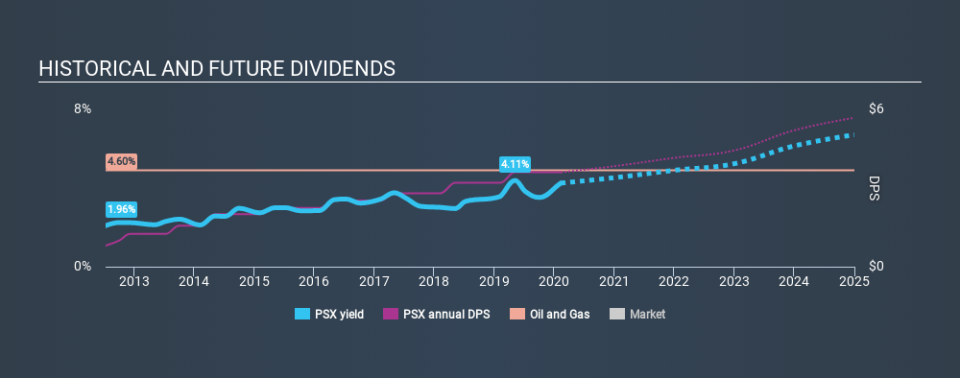Dividend Investors: Don't Be Too Quick To Buy Phillips 66 (NYSE:PSX) For Its Upcoming Dividend

Some investors rely on dividends for growing their wealth, and if you're one of those dividend sleuths, you might be intrigued to know that Phillips 66 (NYSE:PSX) is about to go ex-dividend in just 3 days. You will need to purchase shares before the 14th of February to receive the dividend, which will be paid on the 2nd of March.
Phillips 66's next dividend payment will be US$0.90 per share, on the back of last year when the company paid a total of US$3.60 to shareholders. Calculating the last year's worth of payments shows that Phillips 66 has a trailing yield of 4.0% on the current share price of $90.33. We love seeing companies pay a dividend, but it's also important to be sure that laying the golden eggs isn't going to kill our golden goose! So we need to investigate whether Phillips 66 can afford its dividend, and if the dividend could grow.
View our latest analysis for Phillips 66
If a company pays out more in dividends than it earned, then the dividend might become unsustainable - hardly an ideal situation. Phillips 66 paid out more than half (51%) of its earnings last year, which is a regular payout ratio for most companies. Yet cash flow is typically more important than profit for assessing dividend sustainability, so we should always check if the company generated enough cash to afford its dividend. Phillips 66 paid out more free cash flow than it generated - 168%, to be precise - last year, which we think is concerningly high. It's hard to consistently pay out more cash than you generate without either borrowing or using company cash, so we'd wonder how the company justifies this payout level.
Phillips 66 paid out less in dividends than it reported in profits, but unfortunately it didn't generate enough cash to cover the dividend. Cash is king, as they say, and were Phillips 66 to repeatedly pay dividends that aren't well covered by cashflow, we would consider this a warning sign.
Click here to see the company's payout ratio, plus analyst estimates of its future dividends.
Have Earnings And Dividends Been Growing?
Companies that aren't growing their earnings can still be valuable, but it is even more important to assess the sustainability of the dividend if it looks like the company will struggle to grow. If earnings fall far enough, the company could be forced to cut its dividend. It's not encouraging to see that Phillips 66's earnings are effectively flat over the past five years. Better than seeing them fall off a cliff, for sure, but the best dividend stocks grow their earnings meaningfully over the long run.
Another key way to measure a company's dividend prospects is by measuring its historical rate of dividend growth. Phillips 66 has delivered 21% dividend growth per year on average over the past eight years.
Final Takeaway
From a dividend perspective, should investors buy or avoid Phillips 66? It's not great to see earnings per share have been flat and that the company paid out an uncomfortably high percentage of its cash flow over the past year. Cash flows are typically more volatile than earnings, but this is still not what we like to see. With the way things are shaping up from a dividend perspective, we'd be inclined to steer clear of Phillips 66.
Ever wonder what the future holds for Phillips 66? See what the ten analysts we track are forecasting, with this visualisation of its historical and future estimated earnings and cash flow
A common investment mistake is buying the first interesting stock you see. Here you can find a list of promising dividend stocks with a greater than 2% yield and an upcoming dividend.
If you spot an error that warrants correction, please contact the editor at editorial-team@simplywallst.com. This article by Simply Wall St is general in nature. It does not constitute a recommendation to buy or sell any stock, and does not take account of your objectives, or your financial situation. Simply Wall St has no position in the stocks mentioned.
We aim to bring you long-term focused research analysis driven by fundamental data. Note that our analysis may not factor in the latest price-sensitive company announcements or qualitative material. Thank you for reading.

 Yahoo Finance
Yahoo Finance 
